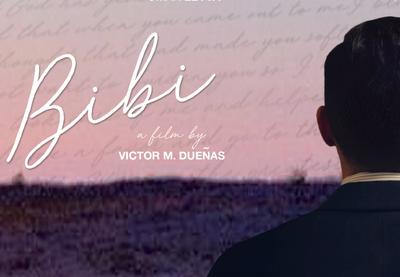“Mira, mi gente, mi familia. To be born in this world as you have been—queer, of color, woman, immigrant—is to inherit a word in an incomplete sentence. We are required to write, and we are required to read what came before, to read and read and read until we know ourselves, and know where we are going, and what we must do to get there. This is our inheritance in a country that gives us little.”
—John Paul Brammer
In the short film Bibi, a two-second scene offers a glimpse of the film’s profound message. Ben Solis, the protagonist, walks through his childhood home in the wake of his father’s death. The decor has changed, but memories linger. He stops to consider a candelabra on the coffee table. He slightly adjusts one candle so that it isn’t standing straight. Facing a different direction, it is still capable of light and warmth—still connected to its base.
The scene is bookended by flashbacks of Ben’s relationship with his father. We see the loving system of communication they created to tackle tough topics together: letters conveying what they struggled to say face to face. And we see the moment when that trusting tradition broke down, when Ben came out as gay to his father. But the film’s power resides in disrupting a simple coming-out narrative, instead confronting complicated themes of intersectionality, communication, privilege, reconciliation and reclamation. The letters are the characters’ vehicles for understanding their own stories—inheritances passed across generations, language and time.
Bibi is the center of an LFJ classroom film kit, which also includes lessons for grades 6-12. The lessons explore the ways our personal and social identities make us who we are; the ways intersectionality affects how we move through the world; and the ways writing can help us convey complex feelings, understandings and thoughts. For every student, the film and lessons offer a way to consider who they are, where they are going and how their story differs from those of their peers.
Stream Bibi for your students. Find the film kit here, and watch the trailer below.
It is a common exercise in education to have students write letters to their younger selves. Implicit in that activity are questions that we often continue to grapple with as adults: What message did you need to receive as a child to feel worthy, accepted or capable? What mirror did you need to truly understand yourself and your capabilities? What understandings would have helped you get to where you needed to be?
In Bibi, students find many mirrors. Some will recognize themselves in Ben’s coming-out narrative and the journey to reconcile their truth with societal expectations. Some will relate to a household held together by a single, working-class parent. Some will see their lives reflected in the beauty and challenges of navigating bilingual communities. Some will detect a resemblance in Ben’s struggle to communicate about puberty with a caregiver. Some will identify with the experience of losing a loved one—through death or estrangement—and the messages that continue to pass between people, even when barriers to communication seem impenetrable.
And all students will understand the power of being listened to—the need to be understood. The importance of such stories cannot be overstated. Too many of our students are left with words in an incomplete sentence. They feel erased in the classroom. They are erased from the canon. They are silenced by codes of respectability, masculinity, white supremacy and forced norms. They scramble to assemble the words to describe their lived experiences, all within a system that often refuses to hear them.
We are proud to support this story as part of an ongoing effort to help students discover the empowering language of identity and diversity and the tools to recognize injustice and act against it.
We hope Bibi offers students the messages they need to receive: messages of love, acceptance, growth and learning. We know the film provides important lessons and understandings that can be passed back and forth, like letters, between and among students and the adults who care for them.

